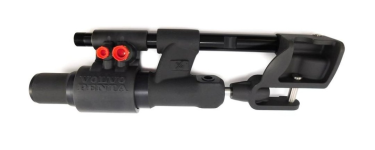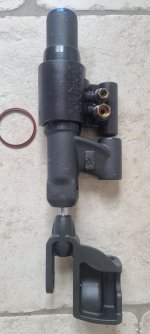I have noticed a leak from the large cylinder (left seal under the 'P' in PENTA) on my 2017 power steering actuator. It is VP part# 21910902 Steering Cylinder SKU: VOL-21910902. Online research indicates the part is non-serviceable. There are after-market seal kits and rebuild services, but they only address leaks in the smaller upper rod. New replacement cost is $850-1100. It will be a very tight install/removal with the boat design.
Fluid level just touched the bottom of the fill stick. I could see where the fluid dripped down into the bottom of the hull and feel a slick of fluid along the bottom of the large cylinder on the starboard side (left side of image below). This is red fluid which I believe is Dextron III ATF and not Volvo Penta power steering fluid. I'm not sure if it came like this from the factory or if this was replaced during service at the marina.
Because our garage is a tight fit, I often swing the motor to one side. This sometimes happens with the engine off by pushing the motor and/or cranking the wheel. Could this cause enough back pressure to be the reason for the leak? How much of a leak is tolerable on something like this? The boat only has 120 hours and the part still looks mint. We do a fair amount of side to side over steer to correct the horrendous bow wander on this hull in order to maintain a heading at low speed (Stingray 198ls).
If I take this on, I would need to either completely drain and refill fluid or top it off as necessary. The Volvo manual specifies Volvo Penta Power Steering fluid (clear) or non-US Dextron 2+ ATF. What does non-US mean? I'm in the US and not Canada. Does anyone know if the alternate fluid could be the reason for the seal failure? I believe Dextron III ATF is a longer lasting fluid (also cheaper) than the clear VP power steering fluid, but would like to hear opinions. I suspect that even if I drain and refill with the clear VP, I'll be stuck with a reddish hue in the reservoir. I can't easily remove the reservoir for cleaning because it is co-molded into the antifreeze tank on this engine (freshwater marine). This makes me want to continue with the red Dex ATF, assuming it's viscosity and/or seal conditioners aren't the cause of the leak.
Lastly, it will need to be bled after installation and topping off the fluid. This will require running the engine out of water which is new to me. I'm assuming I just need to idle the engine and turn the wheel from chalk to chalk until it stops whining? There is a blue fill hose wedged into the back of the SX out drive. Can I use that instead of muffs to run water to the engine? If anyone has done this and has tips, I'm all ears. This would be my first experience running the motor out of water. I'm reluctant to try to bleed the power steering at the launch which tends to be busy and stressful.


Is this a water port to use in lieu of muffs or in addition to them?

Fluid level just touched the bottom of the fill stick. I could see where the fluid dripped down into the bottom of the hull and feel a slick of fluid along the bottom of the large cylinder on the starboard side (left side of image below). This is red fluid which I believe is Dextron III ATF and not Volvo Penta power steering fluid. I'm not sure if it came like this from the factory or if this was replaced during service at the marina.
Because our garage is a tight fit, I often swing the motor to one side. This sometimes happens with the engine off by pushing the motor and/or cranking the wheel. Could this cause enough back pressure to be the reason for the leak? How much of a leak is tolerable on something like this? The boat only has 120 hours and the part still looks mint. We do a fair amount of side to side over steer to correct the horrendous bow wander on this hull in order to maintain a heading at low speed (Stingray 198ls).
If I take this on, I would need to either completely drain and refill fluid or top it off as necessary. The Volvo manual specifies Volvo Penta Power Steering fluid (clear) or non-US Dextron 2+ ATF. What does non-US mean? I'm in the US and not Canada. Does anyone know if the alternate fluid could be the reason for the seal failure? I believe Dextron III ATF is a longer lasting fluid (also cheaper) than the clear VP power steering fluid, but would like to hear opinions. I suspect that even if I drain and refill with the clear VP, I'll be stuck with a reddish hue in the reservoir. I can't easily remove the reservoir for cleaning because it is co-molded into the antifreeze tank on this engine (freshwater marine). This makes me want to continue with the red Dex ATF, assuming it's viscosity and/or seal conditioners aren't the cause of the leak.
Lastly, it will need to be bled after installation and topping off the fluid. This will require running the engine out of water which is new to me. I'm assuming I just need to idle the engine and turn the wheel from chalk to chalk until it stops whining? There is a blue fill hose wedged into the back of the SX out drive. Can I use that instead of muffs to run water to the engine? If anyone has done this and has tips, I'm all ears. This would be my first experience running the motor out of water. I'm reluctant to try to bleed the power steering at the launch which tends to be busy and stressful.


Is this a water port to use in lieu of muffs or in addition to them?

Last edited:




















